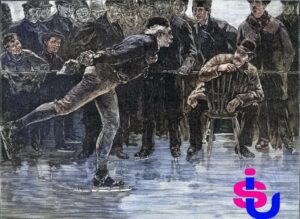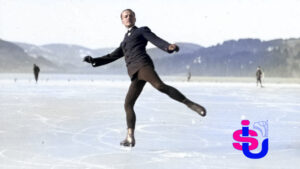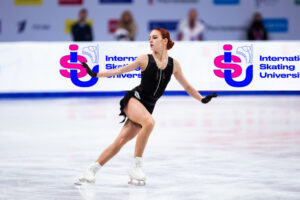Undoubtedly, jumps are the most spectacular and pivotal elements in figure skating, where the professionalism of execution determines the outcome of a performance. There are six types: toe loop, axel, loop, salchow, flip, and lutz. These names are not arbitrary; each jump conceals its own fascinating history.
The toe loop is the simplest of the toe jumps in the discipline. During its execution, the skater initiates a three-turn on the left edge, then, transferring to the right edge, swings the leg backward and propels themselves using the toe pick of the left skate. The first demonstration of this jump was by American athlete Bruce Mapes in 1920. In competitions, a single toe loop is evaluated at 0.4 points, a double at 1.3, and a triple at 4 points. The quadruple toe loop, due to its complexity, is typically better suited for male skaters, although Russian skater Alexandra Trusova successfully presented it at the Junior World Championships.

The axel is one of the most challenging jumps in the sport, performed with a forward approach and involving fewer rotations. The skater, after gliding backward, executing a turn, and swinging the right skate, jumps, completing an additional half-turn in mid-air. The credit for this element goes to the Norwegian Axel Paulsen, who introduced it to the world in 1882 in a Vienna tournament. Axel also invented the “quick step” and developed the first modern figure skates. Initial demonstrations of the jump were by Dick Button and Vern Taylor, with women like Sonja Henie showcasing it. Skaters like Rika Kihira, Elizaveta Tuktamysheva, Anastasia Shabotova, Alena Kostornaia, Sofia Akateva, Alisa Liu, and Sonia Samodelkina have incorporated the axel into their performances. Basic scoring for a single axel is 1.1 points, a double is 3.3, a triple is 8, and a quadruple is 12.5 points.

The loop is one of the recognizable edge jumps, forming a loop pattern on the ice surface after its execution. The skater, crossing the legs beforehand, propels themselves using the edge of the right limb and lands on the same edge. German figure skater Werner Rittberger invented this jump in 1910. The first performer of the double loop is unknown, while Dick Button was the first to present the triple version. Russian figure skaters Alexei Yagudin and Evgeni Plushenko are acknowledged as kings of the quadruple loop, with a single loop scoring 0.5 points, a double 1.7, a triple 4.9, and a quadruple 10.5 points.
The salchow is one of the simpler edge jumps, featuring a change of foot and a positive rotation vector for the skater. The most commonly used approach is a forward-outside three-turn to backward-inside. It is considered easier to achieve the maximum number of rotations compared to other jumps. Swedish athlete Ulrich Salchow introduced this jump in 1909. Timothy Goebel conquered the quadruple salchow, while among women, Alexandra Trusova succeeded in presenting it. Scoring for a single salchow is 0.4 points, a double is 1.3, a triple is 4.3, and a quadruple is 9.7 points.
The flip is the second most challenging of the toe jumps, executed with a backward approach from the inner edge of the left skate and striking the toe pick of the right, followed by landing backward on the outer edge of the latter. Its successful execution requires energetic straightening and thrust from both the take-off and landing legs. The jump earned its name from the sound produced upon striking, resembling a “flip.” The true inventor of this element is unknown, with some speculating it to be Bruce Mapes. The first triple flip was performed by American skater Terry Kubicka, and the quadruple flip by Japanese skater Shoma Uno. Among women, Germans Katarina Witt and Manuela Ruben depicted the triple flip. Single flip scoring is 0.5 points, double 1.8, triple 5.5, and quadruple 11 points.

The lutz is the most complex yet visually striking of the toe jumps executed with a backward approach, resembling a flip in style. The trajectory of movement throughout the element visually resembles an elongated letter S. The free limb of the skater, before take-off, joins the supporting limb, shoulders turn in the direction of rotation, and the take-off limb is positioned a couple of lengths behind the supporting leg, extending sideways. Thanks to a sharp take-off, the skater propels upward. Like most jumps, it is named after its first performer, Austrian Alois Lutz, who presented it in 1913. Notably, the double lutz eluded skaters for a decade, with the triple demonstrated by Canadian skater Donald Jackson and Swiss skater Denise Biellmann. American Brandon Mroz, Russians Alexandra Trusova and Anna Shcherbakova were credited with the quadruple lutz. Scoring for a single lutz is 0.6 points, double 2.1, triple 5.9, and quadruple 11.5 points.
Now that you’ve uncovered the captivating history and intricate details of figure skating jumps, why not take the next step towards mastering them? At International Skating University, we offer a unique online learning experience where you can refine your skills, perfect your technique, and elevate your jumps to new heights.
Join our online lessons to benefit from expert guidance, personalized feedback, and a supportive community of fellow skating enthusiasts. Whether you’re aspiring to perfect the elegance of a toe loop or aiming to conquer the challenge of an axel, International Skating University is here to guide you on your journey.
Don’t just watch the magic unfold; become a part of it! Join our lessons today, and let’s glide towards success together. Your triumphant journey on the ice awaits!
🌟 Lace up, leap forward, and win! 🌟